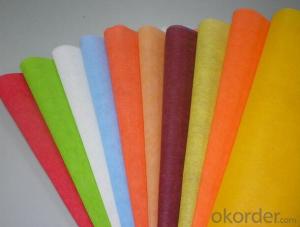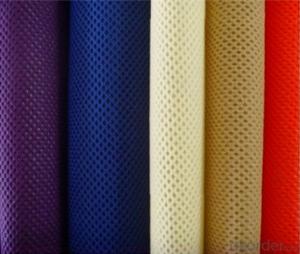Colorful PP Spunbonded Nonwoven Fabric
- Loading Port:
- China Main Port
- Payment Terms:
- TT OR LC
- Min Order Qty:
- -
- Supply Capability:
- -
OKorder Service Pledge
OKorder Financial Service
You Might Also Like
Introduction of polypropylene spunbond non woven fleece fabric is used to protect the crops in agriculture UV resistance masterbatch could be added 1%~8%. It can protect the vegetable crops and new lawns against extreme weather, animal and insect damage, yet allows light, water and air to penetrate, creating protected growing conditions..
Specification of Polypropylene Spunbond Non Woven Fabric:
100% Polypropylene/100% PP
Color:Any color can be available
GSM(gram per square meter): 9-180GSM
Roll Width 4-320cm
Roll Length According to your requirement
Technics Nonwoven Spunbonded
Feature Waterproof, Mothproof, Eco-friendly, Non-toxic, Breathable, Anti-Bacteria
Packing of Polypropylene Spunbond Non Woven Fabric:
Each roll is wrapped in a plastic bag with label specification with paper tube inside .
- Q:The difference between lap and stitching
- Power and load are angular and star connection. When the power supply is connected, the phase voltage of the power supply is equal to the line voltage. The line voltage of the star load is equal to the line voltage of the power supply. The phase voltage of the load is equal to the line voltage divided by the root number. When the power supply is connected, the line voltage of the power supply is equal to three times the root number of the power supply phase voltage. The line voltage of the corner load is equal to the line voltage of the power supply, and the phase voltage is equal to the line voltage. Both at the same time using the corner, the load line voltage is equal to the power line voltage, phase voltage is equal to the line voltage. At the same time using the star, the load line voltage is equal to the power line voltage, the load phase voltage is equal to the power phase voltage, phase voltage equal to the line voltage divided by the root number three.
- Q:Geotextile a square meter how much money
- I professional production, ranging from 3-10 yuan
- Q:Geotextile universal testing machine with 20kn enough?
- Enough, we use is 20kn
- Q:How do geotextiles contribute to sustainable construction practices?
- Geotextiles contribute to sustainable construction practices by providing numerous benefits such as soil stabilization, erosion control, and drainage management. These textile materials act as a barrier, preventing the loss of soil particles and reducing the need for excessive excavation or grading. By minimizing soil erosion and improving water drainage, geotextiles help maintain the structural integrity of construction projects while also minimizing environmental impacts. Additionally, they can be made from recycled materials, promoting sustainability by reducing waste and utilizing existing resources.
- Q:What are the environmental impacts of using geotextiles?
- The environmental impacts of using geotextiles can vary depending on the specific application and the materials used. However, in general, geotextiles can have positive environmental benefits. They can help prevent soil erosion, promote vegetation growth, and provide stability to slopes and embankments. Geotextiles can also facilitate the filtration of water and the retention of sediment, reducing water pollution. Additionally, the use of geotextiles can minimize the need for heavy construction machinery, which can help reduce carbon emissions and minimize disturbance to natural habitats. However, it is important to consider the potential environmental impacts associated with the manufacturing, disposal, and maintenance of geotextiles, as these can contribute to greenhouse gas emissions and waste generation if not managed properly.
- Q:What is the price per square of the non-woven polyester fabric? What is the difference between the geotextile used in the building?
- The price of non-woven polyester fiber cloth is by weight per tonne, higher than the melting point of commonly used geotextiles, strong indicators are also high, longer service life. Building commonly used polyester short wire acupuncture geotextile its strong indicators of low, the price is low.
- Q:What are the durability considerations for geotextiles?
- Durability considerations for geotextiles include factors such as tensile strength, resistance to ultraviolet (UV) degradation, chemical resistance, and abrasion resistance. Geotextiles should have sufficient tensile strength to withstand the stresses and strains imposed on them during installation and the lifespan of the project. UV degradation can weaken geotextiles over time, so it is important to choose products with appropriate UV resistance. Chemical resistance ensures that geotextiles remain intact and functional in the presence of chemicals or contaminants in the soil or water. Additionally, geotextiles should be resistant to abrasion to withstand any potential friction or rubbing against other materials or objects.
- Q:Can geotextiles be used in underground construction projects?
- Yes, geotextiles can be used in underground construction projects. They are commonly used to separate different soil layers, provide filtration, drainage, and erosion control. Geotextiles can also enhance the stability and strength of the underground structures by providing reinforcement and preventing soil movement.
- Q:How do geotextiles help in groundwater protection?
- Geotextiles help in groundwater protection by acting as a barrier that prevents the infiltration of pollutants into the groundwater system. They are used in various applications such as drainage systems, landfills, and erosion control, where they provide filtration and separation of soil particles, ensuring that only clean water enters the groundwater.
- Q:Are geotextiles resistant to hydrocarbons?
- Yes, geotextiles are generally resistant to hydrocarbons.
1. Manufacturer Overview |
|
|---|---|
| Location | |
| Year Established | |
| Annual Output Value | |
| Main Markets | |
| Company Certifications | |
2. Manufacturer Certificates |
|
|---|---|
| a) Certification Name | |
| Range | |
| Reference | |
| Validity Period | |
3. Manufacturer Capability |
|
|---|---|
| a)Trade Capacity | |
| Nearest Port | |
| Export Percentage | |
| No.of Employees in Trade Department | |
| Language Spoken: | |
| b)Factory Information | |
| Factory Size: | |
| No. of Production Lines | |
| Contract Manufacturing | |
| Product Price Range | |
Send your message to us
Colorful PP Spunbonded Nonwoven Fabric
- Loading Port:
- China Main Port
- Payment Terms:
- TT OR LC
- Min Order Qty:
- -
- Supply Capability:
- -
OKorder Service Pledge
OKorder Financial Service
Similar products
New products
Hot products
Related keywords





























